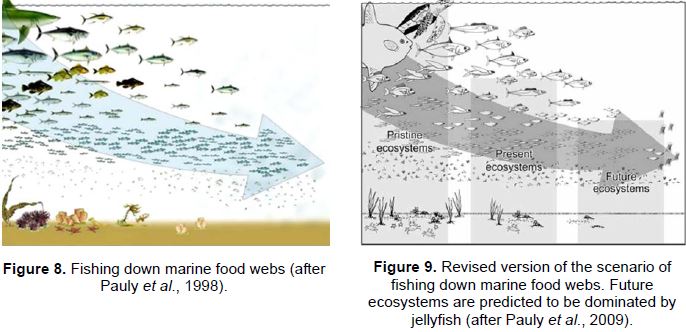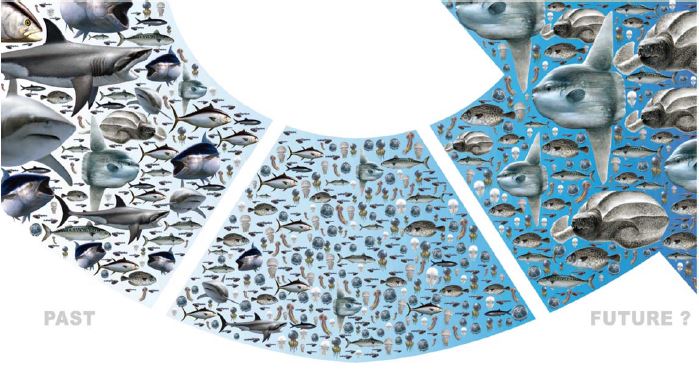1.8. Gelatinous plankton as a source of food
Growing evidence shows that also gelatinous plankton contributes to pelagic food webs as food for higher-level predators (Arai, 2005), but chances are good that their contribution to the sustaining of pelagic food webs is much lower than that of fish.
In the revised figure of Pauly et al. (2009) (Fig. 9), illustrating the process of fishing down marine food webs, jellyfish eating species, such as Mola mola and Caretta caretta are shown in the place of tuna, as in the classical version by Pauly et al. (1998) (Fig. 8).
It is not clear, though, if these species are really disappearing, as suggested by the figure, since Mola mola is not so present in fisheries catches, due to low market prices. If jellyfish are increasing, it might be expected that the species feeding on them, such as Mola mola, are liable to increase, due to higher food availability. Of course, the increase in jellyfish presences might be due to high pressures on their predators, as hinted by Pauly et al. (2009) picture, so that they are released from predation.
But pressures are even higher on their competitors (commercial fish) that use their same food when they are larvae and juveniles.

Figure 8. Fishing down marine food webs (after Pauly et al., 1998).
Figure 9. Revised version of the scenario of fishing down marine food webs. Future ecosystems are predicted to be dominated by jellyfish (after Pauly et al., 2009).
Furthermore, Pope et al. (2010) suggested that shark overfishing releases sunfish from predation and increased jellyfish presences enhance their thriving possibilities. Unfortunately, estimates of sunfish populations are rather vague and their possible increase is highly hypothetical, just as their possible decrease!
Dulcic et al. (2007), however, reported an increase in recent years in the records of Mola mola in the Adriatic Sea. Garibaldi et al. (2010), and Orsi Relini (2010 a, b) recently reported an increase of medusivorous fishes in the Ligurian Sea. The leatherback turtle, Demochelys coriacea, is a specialized eater of gelatinous plankton and is apparently increasing in abundance due to higher food availability (Jones et al., 2011). These increases in medusivorous species might be a response of marine communities to the current abundance of gelatinous plankton, with increases in the populations sizes of the species that take advantage from jellyfish as a source of food (Fig. 10) (for reviews see Arai, 2005; Ates, 1988). Some fish species that feed on jellyfish, such as Mola mola, are not of great commercial importance and, as reported by Orsi Relini et al. (2010a) they appear to be negatively affected by the habit of feeding on jellyfish, their perianal area becoming reddish due to the ingestion of great quantities of Pelagia noctiluca.

Figure 10. The decrease of large fish releases jellyfish from competition with their larvae.
Increased jellyfish availability favors medusivorous species, whose populations increase at the expenses of gelatinous plankton (art by A. Gennari, graphics by F. Tresca).
In conclusion, the situation envisaged by Mills (2001) with the regime shift from a fish to a jellyfish ocean (and embraced also by Pauly et al., 2009) seems to evolve towards the rise of medusivorous species, from gelatinous plankton eating other gelatinous plankton such as Beroe ovata feeding on Mnemiopsis leidyi (see below) to fish and reptiles with jellyfish-based diets.